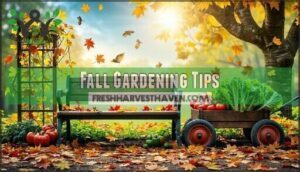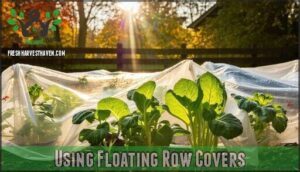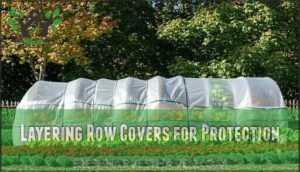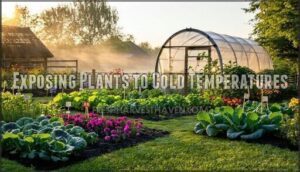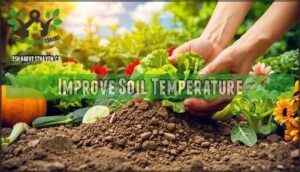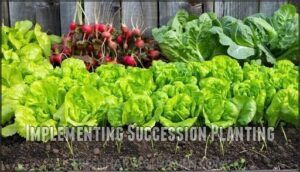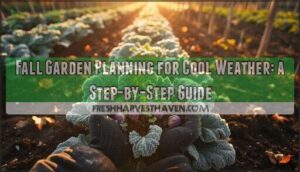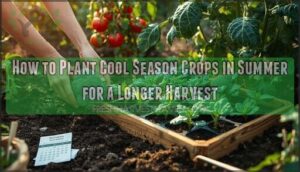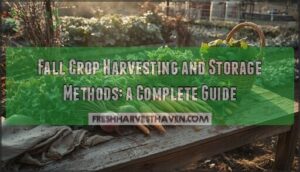This site is supported by our readers. We may earn a commission, at no cost to you, if you purchase through links.
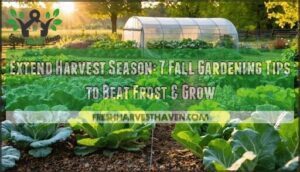
Use row covers, cold frames, or hoop tunnels to protect tender plants from temperature drops.
Plant succession crops every 2-3 weeks through late summer for continuous harvests. Choose fast-maturing varieties that’ll reach maturity before hard freezes hit.
Mulch around plants to regulate soil temperature and prevent root damage. Time your plantings by counting backwards from your first frost date.
These strategies can add weeks or even months to your growing season, turning your garden into a four-season food source.
Table Of Contents
- Key Takeaways
- Extend Harvest Season
- Fall Gardening Tips
- Protect Plants From Frost
- Improve Soil Temperature
- Maximize Fall Harvest
- Frequently Asked Questions (FAQs)
- What is the 3 year rule in gardening?
- How do you plant for a continuous harvest?
- Is September too late to plant fall vegetables?
- What should I be doing in my garden in the fall?
- How do you extend the harvest season?
- Can you extend your garden season into the fall?
- How can I extend the vegetable gardening season?
- When should you plant crops for a fall harvest?
- Does gardening have to end in summer?
- What vegetables can be used with a season extender?
- Conclusion
Key Takeaways
- Plant cold-hardy crops like kale, Brussels sprouts, and carrots – these varieties actually taste better after frost and can survive temperatures that kill summer plants
- Use row covers, cold frames, or hoop tunnels to protect tender plants from frost while allowing light through – you can extend your growing season by weeks or months with these simple barriers
- Start succession planting every 2-3 weeks through late summer with fast-maturing varieties like lettuce and radishes to ensure continuous harvests until a hard freeze
- Apply mulch around plants to regulate soil temperature and prevent root damage – dark mulch works best for heat retention while protecting your investment from winter weather
Extend Harvest Season
You can keep your garden producing fresh food well beyond summer’s end by choosing the right varieties and protective measures.
Strategic fall planting combined with frost protection techniques allows you to harvest vegetables through winter in many climates.
Planting Frost Tolerant Crops
Smart crop selection transforms fall gardens into productive powerhouses.
Choose kale, spinach, and Brussels sprouts for their exceptional frost tolerance.
Plant these hardy varieties in mid-to-late August, timing your planting six weeks before expected frost.
Proper soil preparation and understanding your hardiness zones guarantees these fall crops thrive, extending harvest season naturally through cold weather.
Succession planting with fast-growing vegetables like radishes can also maximize the harvest window.
Using Row Covers for Protection
Row cover materials create a protective barrier around your plants while allowing light transmission for photosynthesis.
These lightweight fabrics provide frost protection by trapping warm air and regulating temperature around crops.
Install them using hoops or stakes, ensuring proper ventilation.
Row covers excel at pest exclusion while extending your harvest season through effective temperature regulation for fall gardening success.
Consider different row cover weights for ideal plant protection.
Building Cold Frame Structures
Cold frames turn garden beds into season extension powerhouses. Build yours with cedar or recycled windows for durability.
Consider these frame materials and design elements:
- Frame Materials: Use cedar boards, bricks, or sturdy posts for longevity
- Glazing Options: Install polycarbonate panels or old windows for light transmission
- Ventilation Design: Add hinges for adjustable lids preventing overheating
- Site Selection: Position south-facing near walls for maximum sun exposure
They function as mini-greenhouses, helping with passive solar heating. This heating alternative provides frost protection while maintaining ideal growing conditions for fall gardening success.
Fall Gardening Tips
You’ll discover that smart plant choices can transform your garden from a summer-only operation into a year-round food source.
Fall gardening requires selecting the right varieties and understanding how cooler temperatures actually improve flavor in many crops, which can be a complete concept to grasp for better gardening results.
Choosing Hardy Perennials
Hardy perennials form the backbone of extended harvest seasons, thriving across diverse Perennial Hardiness Zones with minimal fuss.
Choose varieties like Echinacea and Russian Sage that handle temperatures down to -30°F while meeting specific Soil Requirements and Sun Exposure needs.
These champions reduce Maintenance Tips by 60% once established, requiring only weekly watering during dry spells for successful fall planting and season extension, which involves careful consideration of Soil Requirements.
Selecting Frost Tolerant Annuals
While perennials provide reliable structure, annuals offer quick wins for your fall planting strategy.
Choose varieties bred for cool weather crops like kale, spinach, and arugula that thrive in your Hardiness Zones.
These late season vegetables handle frost better than summer crops, extending harvest well into winter gardening season.
Fall planting allows for stronger root development before winter dormancy.
- Kale keeps producing sweet, tender leaves even after snow covers the ground
- Spinach germinates in cold soil when other seeds refuse to sprout
- Arugula adds peppery zip to salads while temperatures plummet around it
- Mache delivers fresh greens when grocery store prices skyrocket in winter
- Asian greens like tatsoi survive brutal freezes that kill tender plants
Select varieties labeled "winter-hardy" or "frost-tolerant" for best results.
Consider your garden’s Sunlight Needs and Soil Drainage when choosing locations.
Proper Watering Practices and Bloom Timing guarantee these cool-season champions deliver fresh harvests when you need them most.
Concentrating Sugars for Flavor
Beyond choosing frost-tolerant annuals, you can enhance their flavor through cold sweetening.
Many late season vegetables like carrots and parsnips concentrate sugars when exposed to cool temperatures.
Cold-sweetened vegetables taste better than summer ones—frost actually improves their flavor.
This natural process improves taste substantially.
Monitor dehydration effects and use proper post-harvest handling techniques to maximize flavor benefits while extending harvest season.
| Vegetable | Cold Sweetening Effect |
|---|---|
| Carrots | Starches convert to sugars below 40°F |
| Parsnips | Sweetness increases after first frost |
| Brussels Sprouts | Flavor improves with cold exposure |
| Kale | Becomes sweeter after frost exposure |
Protect Plants From Frost
When frost threatens your garden, you don’t have to surrender your harvest. Smart protection strategies can keep your plants productive well into the colder months.
Using Floating Row Covers
Floating row covers transform your garden into a fortress against autumn’s harsh realities. These lightweight fabric shields create a protective microclimate while allowing essential light transmission and airflow.
Various row cover types offer different benefits—spun fabric provides frost protection, while mesh versions focus on pest control. Installation methods vary from simple draping to securing edges with stakes or clips.
- Watch your tender greens survive overnight frosts that would normally devastate them
- Feel the satisfaction of harvesting fresh lettuce while neighbors’ gardens lie dormant
- Experience the joy of extending your growing season weeks beyond nature’s intended timeline
Proper watering needs adjustment since covers reduce evaporation. These season extension techniques prove invaluable for serious gardeners seeking harvest extension. Your fall garden guide should prioritize cover selection based on your specific extending growing season goals.
Layering Row Covers for Protection
When single row covers aren’t enough, stack multiple layers to create extra insulation properties for your fall garden guide.
Double-layering materials traps warm air between covers, boosting protection by several degrees. Monitor condensation control carefully—space layers to prevent moisture buildup that damages plants.
Consider weight considerations when stacking; lightweight fabrics work best. Check light transmission levels regularly, ensuring plants receive adequate sunlight.
Remember that freeze damage occurs below 32°F. This season extension technique helps extend harvest weeks longer than single covers alone.
Exposing Plants to Cold Temperatures
When autumn nights turn cooler, gradually exposing plants to cold temperatures triggers cold acclimation—nature’s own frost protection system.
This hardiness-building process helps extend harvest seasons by preparing crops for colder conditions ahead.
- Start cold stress conditioning 7-14 days before expected frost to maximize plant survival rates
- Lower nighttime temperatures by 1-2°C gradually rather than shocking plants with sudden temperature drops
- Maintain 10-15°C nighttime range while keeping daytime temperatures steady at 20-24°C for ideal hardiness zones adaptation
- Monitor with thermometers to prevent frost damage while building natural antifreeze compounds in plant tissues
- Combine with hoop house protection for enhanced autumn harvest success in vegetable gardening fall seasons
Sudden temperature drops can cause significant cold damage to plants.
Improve Soil Temperature
You’ll get the most from your fall garden by managing soil temperature effectively.
Mulch acts as your soil’s thermostat, keeping roots warm enough to support late-season growth and extending your harvest window.
Regulating Soil Temperature With Mulch
Since mulch acts as nature’s thermostat, you’ll want to apply the right type at proper depths for ideal soil temperature control.
Different mulch materials provide varying insulation levels, affecting your late season planting success and autumn harvest timing.
| Mulch Types | Insulation Depth | Best For |
|---|---|---|
| Straw/Hay | 3-4 inches | Vegetable gardening fall crops |
| Wood chips | 2-3 inches | Perennial beds, pathways |
| Shredded leaves | 2-3 inches | Around established plants |
| Grass clippings | 1-2 inches | Quick decomposition areas |
| Compost | 1-2 inches | Soil improvement zones |
Proper mulch depth regulates watering needs while controlling decomposition rate and pest control issues.
Understanding mulch’s impact on soil is vital for effective gardening.
Monitor soil temperature under your hoop house coverings to guarantee consistent growing conditions for your gardening tips success.
Using Dark Mulch for Heat Retention
Dark mulch acts like nature’s solar collector, absorbing and storing heat throughout the day.
Materials like shredded bark or compost create configuration dictionaries for ideal plant-specific needs, extending your late season planting window.
This gardening tip delivers consistent heat retention duration while maintaining soil moisture impact.
To further enrich the soil, consider the benefits of adding organic matter.
Choose darker materials as your default values injection for maximum thermal benefits and sustained growing conditions, creating an ideal environment for late season planting.
Preventing Erosion With Mulch
Beyond warmth retention, mulch serves as your garden’s natural armor against erosion.
Rain and wind won’t steal precious topsoil when you’ve got the right coverage strategy.
Here’s your erosion-fighting game plan:
- Mulch Types: Choose organic options like shredded leaves or wood chips that interlock naturally
- Slope Stability: Apply thicker layers on inclined areas where water runs fastest
- Application Techniques: Spread evenly, leaving space around plant stems for proper airflow
This approach mirrors how you’d append data analysis results to an iterable object – each mulch layer builds upon the previous one.
Your extend method creates water retention while protecting soil health from seasonal damage.
Maximize Fall Harvest
You’ll want to squeeze every possible harvest from your garden before winter arrives.
Smart planning with succession planting, inter-planting techniques, and short-season varieties can extend your growing season by weeks and boost your total yield substantially.
Implementing Succession Planting
You can maximize garden productivity through staggered planting and continuous harvest techniques.
Plant fast-maturing crops like lettuce and radishes every 1-2 weeks through early fall.
This approach mirrors Python’s extend method—adding multiple elements to your harvest list systematically.
| Crop | Days to Maturity |
|---|---|
| Lettuce | 30-45 days |
| Radishes | 25-30 days |
| Spinach | 40-50 days |
| Carrots | 60-70 days |
Succession planting guarantees fresh produce until frost while optimizing resource management through efficient crop rotation and variety selection.
Inter-Planting for Maximum Yield
Beyond succession planting, companion planting reveals your garden’s full potential.
Interplant fast-maturing radishes between slow-growing carrots—you’ll harvest radishes before they compete for space. Plant nitrogen-fixing beans alongside heavy feeders like corn for natural resource sharing. This space optimization technique delivers higher yields per square foot.
- Layer crops vertically – Plant climbing beans on corn stalks while squash spreads below
- Stagger harvest times – Combine 30-day radishes with 70-day beets for continuous production
- Match complementary root depths – Pair shallow lettuce roots with deep carrot taproots
Researching Short Season Varieties
Beyond simple inter-planting, you’ll want to focus on variety selection for early maturity and cold hardiness.
Research cultivars bred for shorter seasons, typically maturing within 60-90 days. These selections maximize your harvest window before hard frost arrives.
| Crop Type | Variety | Days to Maturity |
|---|---|---|
| Tomatoes | Sub Arctic Plenty | 42 days |
| Peppers | Yankee Bell | 60 days (green) |
| Broccoli | Belstar | 58 days |
| Onions | Purplette | 60 days |
| Beans | Bush Blue Lake | 50 days |
Local adaptation matters most when seed starting. Test varieties in your microclimate to identify top performers for future seasons.
Frequently Asked Questions (FAQs)
What is the 3 year rule in gardening?
The 3-year rule explains perennial plant growth: "sleep" the first year while establishing roots, "creep" during the second year with moderate growth, then "leap" in the third year with full flourishing and peak performance.
How do you plant for a continuous harvest?
Succession sowing supercharges your supply! Plant lettuce every 2-3 weeks, stagger bean varieties, and intercrop fast growers like radishes between slower crops. You’ll maintain consistent harvests throughout seasons.
Is September too late to plant fall vegetables?
September isn’t too late! You can plant cool-season crops like spinach, lettuce, radishes, and kale. They’ll thrive in cooler weather and give you fresh harvests through fall.
What should I be doing in my garden in the fall?
Fall brings golden opportunities for garden care. Harvest remaining crops, plant cool-season vegetables like kale and radishes, mulch beds heavily, clean up debris, and prepare garden tools for winter storage.
How do you extend the harvest season?
Don’t count your chickens before they hatch—start succession planting early.
Plant cold-hardy crops like spinach, kale, and carrots every two weeks.
Use row covers and cold frames to protect plants from frost and extend your growing season well into winter.
Can you extend your garden season into the fall?
Yes, you can definitely extend your garden season into fall using cold-hardy crops, row covers, and succession planting techniques to maximize your harvest window.
How can I extend the vegetable gardening season?
You can stretch your vegetable gardening season by using row covers, cold frames, or hoop tunnels to protect crops from frost, while planting cold-hardy varieties like kale and spinach.
When should you plant crops for a fall harvest?
Most successful fall crops need 10-12 weeks before your first frost date. You’ll plant lettuce, spinach, and radishes in late summer, around 8-10 weeks before frost hits your area.
Does gardening have to end in summer?
Fall and winter gardening extends your growing season beautifully. You’ll harvest cold-hardy crops like kale, carrots, and Brussels sprouts well into winter, maximizing your garden’s potential year-round.
What vegetables can be used with a season extender?
Some 90% of vegetables thrive under row covers or cold frames. You’ll have success with spinach, kale, lettuce, carrots, radishes, Brussels sprouts, and broccoli extending their growing seasons substantially.
Conclusion
Like ancient farmers who knew winter’s secrets, you can master these extend harvest season fall gardening tips to transform your garden into a year-round producer.
Choose cold-hardy varieties, protect plants with row covers, and use succession planting for continuous harvests.
Strategic mulching and proper timing guarantee your crops survive freezing temperatures.
These proven techniques will keep fresh vegetables on your table long after neighbors’ gardens have gone dormant, maximizing both your investment and harvest potential.

